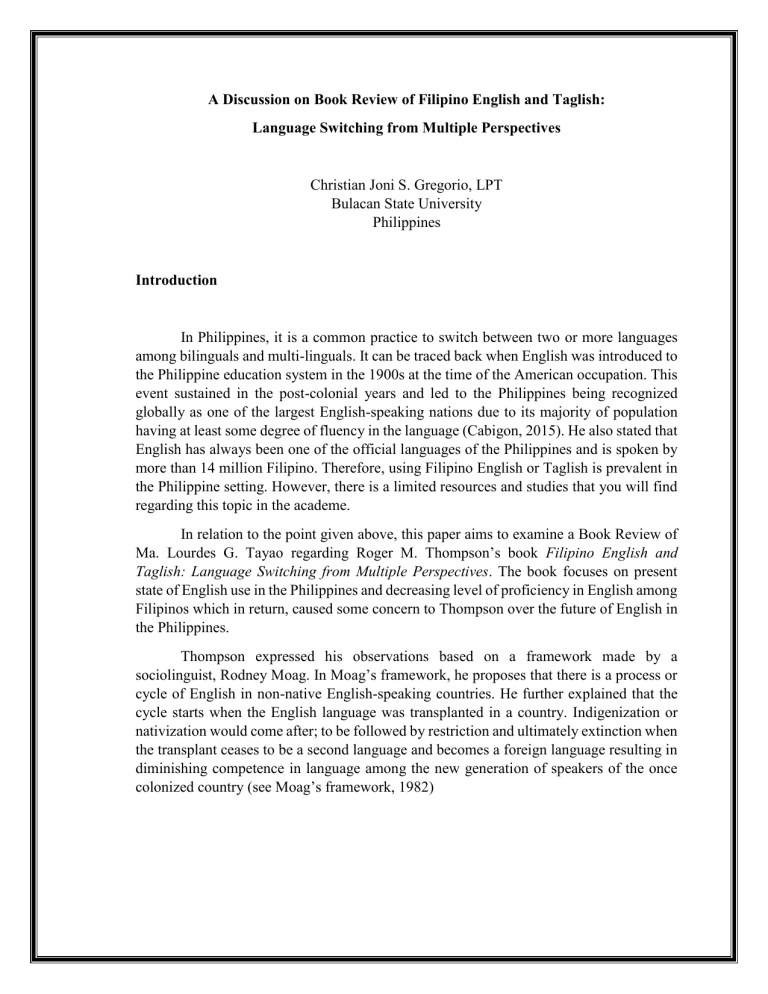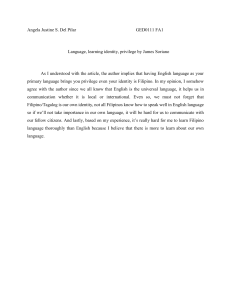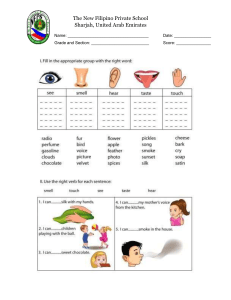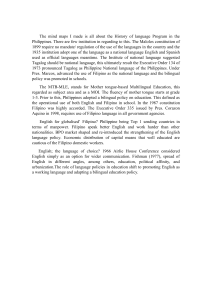
A Discussion on Book Review of Filipino English and Taglish: Language Switching from Multiple Perspectives Christian Joni S. Gregorio, LPT Bulacan State University Philippines Introduction In Philippines, it is a common practice to switch between two or more languages among bilinguals and multi-linguals. It can be traced back when English was introduced to the Philippine education system in the 1900s at the time of the American occupation. This event sustained in the post-colonial years and led to the Philippines being recognized globally as one of the largest English-speaking nations due to its majority of population having at least some degree of fluency in the language (Cabigon, 2015). He also stated that English has always been one of the official languages of the Philippines and is spoken by more than 14 million Filipino. Therefore, using Filipino English or Taglish is prevalent in the Philippine setting. However, there is a limited resources and studies that you will find regarding this topic in the academe. In relation to the point given above, this paper aims to examine a Book Review of Ma. Lourdes G. Tayao regarding Roger M. Thompson’s book Filipino English and Taglish: Language Switching from Multiple Perspectives. The book focuses on present state of English use in the Philippines and decreasing level of proficiency in English among Filipinos which in return, caused some concern to Thompson over the future of English in the Philippines. Thompson expressed his observations based on a framework made by a sociolinguist, Rodney Moag. In Moag’s framework, he proposes that there is a process or cycle of English in non-native English-speaking countries. He further explained that the cycle starts when the English language was transplanted in a country. Indigenization or nativization would come after; to be followed by restriction and ultimately extinction when the transplant ceases to be a second language and becomes a foreign language resulting in diminishing competence in language among the new generation of speakers of the once colonized country (see Moag’s framework, 1982) However, according to Gonzales (1997), extinction won’t be the end process of English in the country, but rather a revivification with rapid and significant linguistic changes in a least two sociolects. He further pointed out two possible scenario that would likely to happen: “A colloquial mesolect for everyday communication and an acrolect closer to an international standard for mutual intelligibility with the other users of English as an international auxiliary language.” (Gonzales, 1997) One possible outcome also would be the continuing usage of code-switching or code-mixing in the country which according to Tayao (2014) is proving to be true in the Philippine situation and which could be taken as a sign of creolization and/or the ultimate demise of English in the country. Future of English in the Philippines The review proceeds with the discussion regarding Thompson adopting multiple perspectives in different interlocutors in varied domains, modes and locales. Additionally, he did not focus on the linguistic features of Taglish as his framework was also based on Fairclough’s (1995) suggestion. Thompson (2003) pointed out that to understand how Filipino language switching works in discourse, we need to look beyond an analysis of the language itself. We must not only look at when Taglish is used, but we must also look at the social effect of Taglish in the promotion of certain ideologies” (4). Tayao (2014) added that Thompson suggests that we should not focus on what but instead turn our attention to the whys pertaining to the linguistic phenomenon of code-switching. He also focuses on the context or sociopolitical conditions that gave rise to the phenomenon and does not limit attention to the phenomenon itself. In order to analyze the problem of the study further, Thompson raised three research questions that examined different perspective, using varied data and drawing a specific methodology to arrive at answers to the question raised. Finally, reporting results in a particular section or part of the book. The table below presents schematically the contents of the book as provided by Tayao (2014): Table 1. The table shows Thompson’s schematic table of the contents of his book To conclude his book, Thompson stated that the future of English in the Philippines does not look good and based on Moag’s model of the fate of transplanted colonial languages that starts with transportation or transplantation to be followed by expansion, then by nativization or indigenization, next by restriction that finally ends with extinction or demise excluding some large number of lexical terms, he predicted that: “Once an intellectualized version of Filipino is accepted for a wide variety of scientific, technical, and professional purposes, English will die out except among an elite few, as French did centuries ago in England. English will then have completed its life cycle in the Philippines.” (Thompson, 2003) Filipino English or Taglish? At the beginning of the review, Tayao raised some questions that came to her mind when she starts to read the book. One question inquires: “Is the writer saying that Filipino English and Taglish are two distinct varieties of English used in the Philippines or is he using those two terms to refer to just one variety, the one currently used by a good number of Filipinos, one that is marked by code-switching and the blending of two languages – American English, a transplanted foreign language resulting from colonization, and Tagalog, one of the indigenous languages native to the country?” This question came from the author’s observation regarding the title of the book, specifically the use of two variables: Filipino English and Taglish. But after discussing the gist of the book, she also provided a definite answer to such questions. According to Tayao (2014), the construct in Thompson’s title do not seem to refer to two distinct varieties of English used by Filipinos except for a few incidental remarks that may be said to refer to Filipino English, that is, English used by Filipinos. She then described the kind of English language that is being utilized here in the Philippines – an evolving Philippine variety of English which is based on American English, one of the official languages in the country. Finally, the author concluded that everything said in the Thompson’s book pertains to Taglish. Product or Process? In her introduction, Tayao also inquired a second question to whether Thompson is referring to the product itself, that is Taglish, the variety now in place and seemingly gaining ground, or is he looking at the process, that is, the different stages of development of Filipino English leading up to Taglish and venturing a guess as to what lies beyond? She then proceeds with providing a clear answer to her own questions wherein she stated that Thompson may be focusing more on the process whereby Taglish results from the dynamics of the restriction phase in the so-called life cycle of a transplanted colonial language. But Tayao (2014) isn’t convinced with Thompson’s point as his fixation with Moag’s theoretical construct has circumscribed Thompson’s study and used it simply to prove a point and evidence in his conclusion. Because of this point, Tayao hypothesized that his claim – a dismal future of English in the country – is open to question. Some Commendable Features In the latter part of the review, the author presented some commendable features in Thompson’s work. One of the things Tayao mentioned is the use of ideologies underlying the shifts in a language switching or code-switching. It is because on adopting Fairclough’s (1995) suggestion, he was able to look beyond an analysis of the language itself on a better understanding of code-switching in discourse. Another case to prove her point is when Thompson decided to investigate the social support given in English outside the classroom in his Part B of study. Because of this, it can be determined if English can be maintained as a second language stemmed from Ferguson’s (1959) concept of diglossia and Fishman’s (1967) extension of the meaning of that term to explain why two different forms of a language or any two or more languages, whether related or not, can maintain a stable relationship with each other over several generations. Tayao also mentioned the notable research design of Thompson as he used multiple perspectives (historical, sociological, sociopolitical, and discoursal). According to her, the book provides a rich source of possible instruments to use in sociolinguistic research. The write-up of the research – a three-part presentation – were also commended by the author. Poor LPP leads to a country of English-speaking Zone There are some concerns regarding the current Language Planning and Policy here in the Philippines and it’s directly affecting our current and future generations – particularly in their curriculum. Some scholar suggests that if not retrofitted, it would lead to a country of English-speaking zone but can’t use it in higher levels of thinking and discoursing (Demetrio and Liwanag, 2014). They further added that other graduates without the adequate English proficiency could not as well use the national and regional languages in higher levels of thinking and discoursing. Their statement was formulated after they studied the Language Policies and and Practices of Philippines and Thailand. Moreover, the efficiency in the way Thailand makes use of its comparatively weaker educational infrastructure and culture could have been the result of its insistence on using Thai as the primary medium of instruction. The country may not produce many English-speaking graduates, but the majority of its Thai-speaking graduates can actually use the Thai language in higher levels of thinking and discoursing. Finally, they concluded that this capability is what powers Thailand through their continuing progress. Cultural Amnesia Closing a speech community’s mind and the onset of cultural amnesia. This is what Sugbo (2003) stated in his study when he reviewed the Language Policy and Local Literature in the Philippines. This greatly affects our society as language and culture intertwine. He further presented in his study that there is a growing dominance of English according to a survey of the newspapers between the mid-1950s and the early 1970s. The result was a gradual displacement of Waray from the pages of newspapers and the growing disinterest in literary production in Waray. Domination of Both Languages To conclude this paper, the researcher hereby confers that both English and Filipino have dominated the education system in the Philippines whereas English is seen as the language of opportunities and have been used by Filipinos to work abroad and find opportunities in the age of globalization while Filipino, on the other hand, is seen as the language that can give identity to Filipinos, although not everyone agrees. Will English and Filipino continue to dominate the country? With the current ideologies and policies put in place, it will. However, as other language speakers continue to fight for their identity and the right to be taught in their mother tongue, we might be able to see some changes, allowing for recognition of other languages in the country, and maybe even be given the same status as English and Filipino (Karunungan, 2019). Code-switching as a Powerful Tool Another conclusion that can be figured out based on Tayao’s review is that codeswitching can be utilized as a powerful tool if managed correctly. In relation to this point, there are various studies that shows positive attitude towards code-switching, and it can be utilized in our favor in the field of academe. First among the list is conducted by Lee (2010) wherein he indicated that the study shows that code switching is widely accepted by teachers in the teaching and learning of English language in secondary schools in the state of Labuan. The research takes place at Philippine’s neighbor country – Malaysia. He concluded in his paper that teachers do use code switching in the classroom as they believe it helps students learn the target language. The findings indicate that code switching is necessary when the situation requires the use of mother tongue or the first language in the classroom (Lee, 2010). Another study which takes place at Mindoro, Philippines. Karizza P. Sotelo, the researcher, explored the tagalog-english code-switching types used for Mathematics classroom instruction. She deduced that in her study that both languages are complementary for instruction as using pure Tagalog or pure English during the discussion poses limitations. She further added that speaking in pure Tagalog can be preventive as Math terms that are essential in understanding math concepts are – most of the time – in English and unless such terms will have an equivalent word in Tagalog, it will be challenging on the part of the teachers. On the other hand, using pure English in the teacher’s instruction would be a cause of concern since there are some considerations in the teacher’s English language proficiency, lesson delivery, and student’s capacity to understand the lesson. Therefore, Tagalog-English switching is both instrumental and inevitable (Sotelo, 2020). She added that it is instrumental because it lessens students’ cognitive burden of understanding both language and content at once and can add insightful ideas while speaking in Tagalog. Lastly, is the study done by Gregorio (2021) wherein he examined the relationship between the code-switching of Filipino teachers in classes and students’ confidence in their Filipino classes. His work confers that code-switching of Filipino teachers makes the students more comfortable to learn, less stressful and perceives code-switching as part of their classroom instruction. The researcher also posits that students look at code-switching this way because students in this generation are more exposed in English because of school, media, signages and economic reasons (Gregorio, 2021). Accepting English and Empowering Filipino Language. Based on the conclusions presented, the researcher hereby recommends accepting English and at the same time empowering Filipino language in our country should do no harm. Moreover, it is unlikely that the presence of English in Filipino societies is the root of the lack of success of the national language in our nation. It is more likely the resistance of our people to a national language which they perceive as being forced upon them by a dominant ethnic group. This statement was supported by Dardjowidjojo’s (1998) study in his paper Strategies for a Successful National Language Policy: The Indonesian Case. On the other hand, we should also focus on empowering Filipino language to strengthen the core of our identity. Demetrio and Liwanag (2014) suggests that instead of not attending to or blocking a more robust implementation of Filipino, the local leaders and intellectuals should focus their energies in lobbying for a more inclusive codification/elaboration of Filipino by proposing the adaptation of more vocabularies from their regional languages and even the recognition of their idiosyncratic grammar as legitimate variants of Filipino. References Bravo-Sotelo, K. P. (2020). Exploring the Tagalog-english code-switching types used for mathematics classroom instruction. IAFOR Journal of Education: Language Learning in Education, 8(1). https://doi.org/10.22492/ije.8.1.03 Cabigon, M. (2015, November). State of English in the Philippines: Should we be concerned? State of English in the Philippines: Should We Be Concerned? | British Council. Retrieved November 11, 2021, from https://www.britishcouncil.ph/teach/state-english-philippines-should-we-beconcerned-2. Dardjowidjojo, Soenjono. 1998. Strategies for a Successful National Language Policy: the Indonesian Case. International Journal of the Sociology of Language 130. Demetrio, F. P. A., & Liwanag, L. A. L. (2014). The Language Policies and Practices of the Philippines and Thailand: Insights and Lessons for Language Planning. Silliman Journal, 19–57. Fairclough, Norman. 1995. Critical Discourse Analysis: The Critical Study of Language. London: Longman. Ferguson, Charles A. 1959. “Diglossia.” Word 15. 325-340. Fishman, Joshua A. 1967. “Bilingualism with and without diglossia, diglossia with and without bilingualism.” Journal of Social Issues 23. 29-38. Gregorio, C. J. S. (2021). Halina’t Mag-study: An Inquiry Between Code-Switching of Filipino Teachers in Classes and their Students’ Confidence in Filipino Classes (thesis). Gonzalez, Andrew B. 1997. “The history of English in the Philippines.” In Ma. Lourdes S. Bautista (ed.), English is an Asian Language: The Philippine Context. NSW, Australia: The Macquarie Library Pty. Ltd. 25-40. Karunungan, R. (2019, August 15). A history of the Philippines' official languages. reneekarunungan.com. Retrieved November 24, 2021, from https://reneekarunungan.com/2019/08/15/a-history-of-the-philippines-officiallanguages/. Lee, H. L. (2010). Code Switching in the Teaching of English as a Second Language to Secondary School Students . Malaysian Journal Of ELT Research, 6. Ma. Lourdes G. Tayao (2004) Book ReviewFilipino English and Taglish: Language Switching from Multiple Perspectives, Asian Englishes, 7:2, 112-119, DOI:10.1080/13488678.2004.10801144 Moag, Rodney F. 1982. “The life cycle of non-native Englishes: A case study.” In Braj B. Kachru (ed.), The Other Tongue: English across Cultures. Urbana: University of Illinois Press. 270-288. Sugbo, V. N. (2003). Language policy and local literature in the Philippines. University of the Philippines - Visayas.





